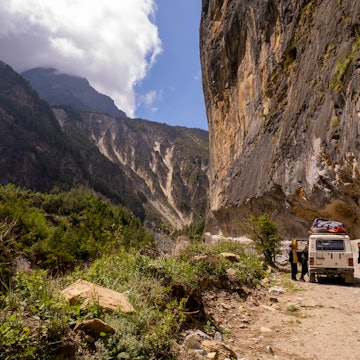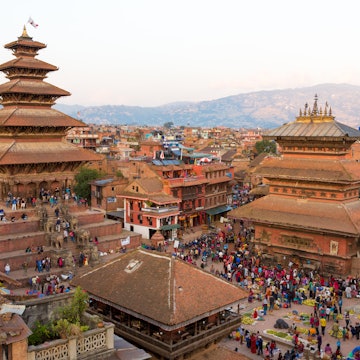

The Terai's richly biodiverse national parks are home to incredible species of animals including the Asian elephant © Utopia_88 / Getty Images
Most visitors to Nepal are so preoccupied by its dramatic Himalayan skyline and spectacular temples that it’s all too easy to overlook the lowland gems of the Terai plains bordering India.
Venture down here, however, and you’ll discover a quite different Nepal; a land where the Buddha was born a pampered prince, where some of the world’s best tea grows on emerald hills, and where ancient Hindu myth becomes daily reality. The real pearls of the Terai are the national parks, wildlife reserves and wildlife corridors strung along the border like a chain of pearls, and the tigers, rhinos, elephants and leopards that stalk the pristine grasslands and subtropical forests here.
Once a malarial buffer zone that now holds the bulk of Nepal’s population and industry, and with a culture that has more in common with northern India than with Himalayan hill communities, the Terai is a great place to travel beyond Nepal’s tourism veneer. Beyond Chitwan National Park you won’t find much of the backpacker infrastructure that characterizes so much of Kathmandu and Pokhara. A grittier, more authentic and, most excitingly, a wilder Nepal awaits.
The Terai region of Nepal is one of the best regions to visit next year. See our full list of Best in Travel 2025 winners.
When should I go to the Terai?
The most comfortable time to visit the Terai is during the relative cool of winter from November to February. The absolute best time for wildlife watching in Chitwan National Park is from late January to March, when the 8m-tall phanta (elephant grass) has been cut, making animals easier to spot.
Months to avoid are the searingly hot months of April and May, when temperatures hit 40°C (104°F), and the rainy monsoon season (June to mid-September), when flooded rivers and leeches make travel unpleasant.
In terms of festivals, Buddha Jayanti, which follow the lunar calendar but usually falls in April or May, sees crowds of Buddhist pilgrims celebrating the birth of the Buddha at his birthplace in Lumbini. In December tens of thousands of Hindu pilgrims from across the subcontinent travel to Janakpur to take part in a re-enactment of the marriage of Sita to Rama, as Rama’s image is carried to the temple by elephant. Rama’s birthday is celebrated here by large crowds of sadhus in March or April depending on the Hindu lunar calendar.

How much time should I spend in the Terai?
If you just want to visit Chitwan National Park, give yourself two full days there to maximize your chance of spotting big-ticket megafauna. You’ll need to also figure in a day to get there from Kathmandu or Pokhara and a day to get back, though these days can usefully be combined with a dawn or dusk safari.
With a week up your sleeve you could add on a day in Lumbini, visiting the birthplace of the Buddha, and a quick wildlife safari at Bardia.
If you are headed overland to India you can easily visit the tea plantations of Ilam en route to Darjeeling; Chitwan en route to Patna in Bihar; or Lumbini en route to Varanasi in Uttar Pradesh. To get right off the beaten track head to the far western attractions of Bardia and Shuklaphanta (Sukla Phanta) national parks, before crossing into the Indian Himalayan state of Uttarakhand.
Is it easy to get in and around the Terai?
The Terai has airports at Siddhartanagar (Bhairawa; for Lumbini), Bharatpur (for Chitwan), Nepalganj (for Bardia), Dhangadhi (for Shuklaphanta) and Biratnagar (for Koshi Tappu and the far east).
Siddhartanagar’s Gautam Buddha airport is theoretically classed as an international airport, but in reality most international flights to Nepal arrive at Kathmandu, from where domestic flights serve the Terai.
The largely flat Terai has frequent local bus connections, though few are comfortable or air-conditioned. Avoid night buses as road traffic accidents are common. More comfortable air-conditioned tourist buses run to Chitwan from Kathmandu, Pokhara and the Indian border at Sonauli.
Renting a car and driver is the most comfortable way to combine multiple sights on a multi-day trip. Bicycles are a good way to get around Lumbini. You can even walk through sections of Chitwan and other national parks, in the company of a guide.
Top things to do in the Terai

1. Chitwan National Park
This former hunting reserve is a UNESCO World Heritage Site and one of the best wildlife-viewing parks in Asia, especially if you want to catch sight of the park’s big three inhabitants: one-horned rhinos, wild Asian elephants and the ever-elusive Bengal tiger. A combination of lakes, sal forests and grasslands in the floodplain of the Rapti River offers shelter to 68 species of mammals and 544 species of birds, which you can spot on foot, in a dugout canoe, or in a 4WD safari. It’s the jewel of the Terai and a true environmental success story, with the numbers of rhinos and tigers increasing every year.
To add a human dimension to your wildlife experience, skip backpacker-style Sauraha town and stay in quieter Barauli in an indigenous Tharu, women-run community homestay, where you can learn how to cook Tharu-style curries and explore local villages by bicycle. The organization also offers homestays and experiences in Tansen, Bardia, Ilam and other rural villages across the Terai.
2. Lumbini
As the birthplace of the Buddha, the World Heritage Site of Lumbini is one of the world’s major pilgrimage centers. A modest marker stone (protected by bulletproof glass) in the excavated Maya Devi Temple marks the spot where Siddharta Gautama was born around 563 BCE. Buddhist pilgrims meditate quietly in the surrounding grounds, a stone’s throw from a commemorative pillar erected by the Buddhist emperor Ashoka in 249 BCE. It’s a quietly powerful site.
In recent years many Buddhist countries have built temples in Lumbini and a stroll here highlights the cultural adaptability of Buddhism, as you pass temples in Chinese, Korean, Tibetan, Burmese and Cambodian national styles. If you are inspired by the site, you can sign up for a free meditation class or even a weeklong silent vipassana meditation retreat.
Prince Siddharta spent the first 29 years of his life in royal seclusion at Kapilavastu, modern Tilaurakot, 29km west of Lumbini. Head to the archaeological site and you can stand at the east gate, from where Siddharta rode out to start his quest for spiritual enlightenment.
3. Bardia National Park
Home to almost as many Bengal tigers as Chitwan (125 compared to Chitwan’s 128) but with only a tiny fraction of its visitors, Bardia National Park is in many ways a better place to spot tigers than its more famous cousin. It’s the largest national park in the Terai, so offers plenty of elbow room for rhinos, tigers and leopards, as well as gharial and even Gangetic dolphins. As in Chitwan, you can opt for guided jungle walks, 4WD safaris or bird-watching floats down the Karnali River.
Even further west is even less-visited Shuklaphanta National Park, whose serene grasslands are home to 36 Bengal tigers and Nepal’s largest population of swamp deer, often seen in herds of several hundred strong.

4. Koshi Tappu Wildlife Reserve
Birders should make a beeline for Koshi Tappu Reserve in the eastern Terai, where the floodplain and freshwater marshes of the Sapt Kosi host over 500 species of birds, including rarities like the swamp francolin and Bengal florican, as well as winter migratory species from Tibet and Siberia (November to February). Most lodges here offer resident birding guides, but even without one you’ll enjoy the park’s delightful 6km-long paved walking trail. The park is named after the tappu (islands) found in the park’s Sapt Kosi river.
5. Janakpur
According to the Hindu epic the Ramayana, the city of Janakpur in the eastern Terai is where Sita, the daughter of local King Janak, was born and later married the god Rama, at a spot marked by today’s wedding-cake style Janaki Mandir. Steeped in religious fervour, the pilgrimage site hosts some spectacular festivals and is particularly popular with Nepali women.
The town once formed the heart of the ancient kingdom of Mithila, whose artistic heritage is still visible in the colorful folk paintings and murals created by village women; the Janakpur Women’s Development Centre sells art and offers a rare insight into traditional life from a female perspective.
6. Go exploring
There’s plenty of room for off-the-beaten-track exploring in the Terai. Head to the hill town of Ilam in the far east and you can hike through emerald hills to tea plantations and sacred lakes. The Newari hill town of Tansen (Palpa) is another excellent place to explore on foot, with footpaths leading to hilltop viewpoints, palaces and temples. For some wilder exploring, head to the far west and make the 10-day trek to Khaptad National Park.

My favorite thing to do in the Terai
Chitwan National Park offers some real bucket-list experiences. The pulse-raising thrill of walking on foot through the forest, knowing that a rhino or tiger could be just around the corner is enough to amp up your adrenalin. Doing that same walk in the company of an elephant ups the ante even further.
Other experiences offer a bit more zen. Floating silently down the river in a traditional dhunga (dugout canoe) is my favorite way to soak up the sounds of the forest. And at the end of a day’s wildlife spotting nothing beats a cold gin and tonic, as the sun sets over elephants bathing in the Narayani river at the pioneering Tiger Tops Tharu Lodge.
How much money do I need for the Terai?
Travel in the Terai can be as cheap or expensive as you wish. Budget hotels cost around US$10 to US$20 for a double, with the upper range offering air-con rooms, while famous luxury lodges like Tiger Tops and Temple Tiger on the edge of Chitwan National Park cost US$200 per person per night, including food and safaris. Meals in backpacker restaurants generally cost US$5 or less for a main course; a beer can double your bill.
Activities will take up a chunk of your budget. A half-day jeep safari Chitwan costs US$100 split between up to seven passengers, with a guided canoe and jungle walk costing between US$15 and US$25, plus a daily park entry fee of US$17 per person. In general, though, Nepal is an excellent-value destination.
What to bring on a trip to the Terai?
Bring DEET-based insect repellent for the mosquitoes and leech repellent if you are walking through the forest during the rains. For wildlife spotting, bring a long-sleeved, long-trousered wardrobe of neutral colors, as well as a sun hat. Wildlife enthusiasts should bring their own binoculars or spotting scope, as well as a bird-identification phone app, such as Birds of India or Eguide to the Birds of the Indian Subcontinent.















